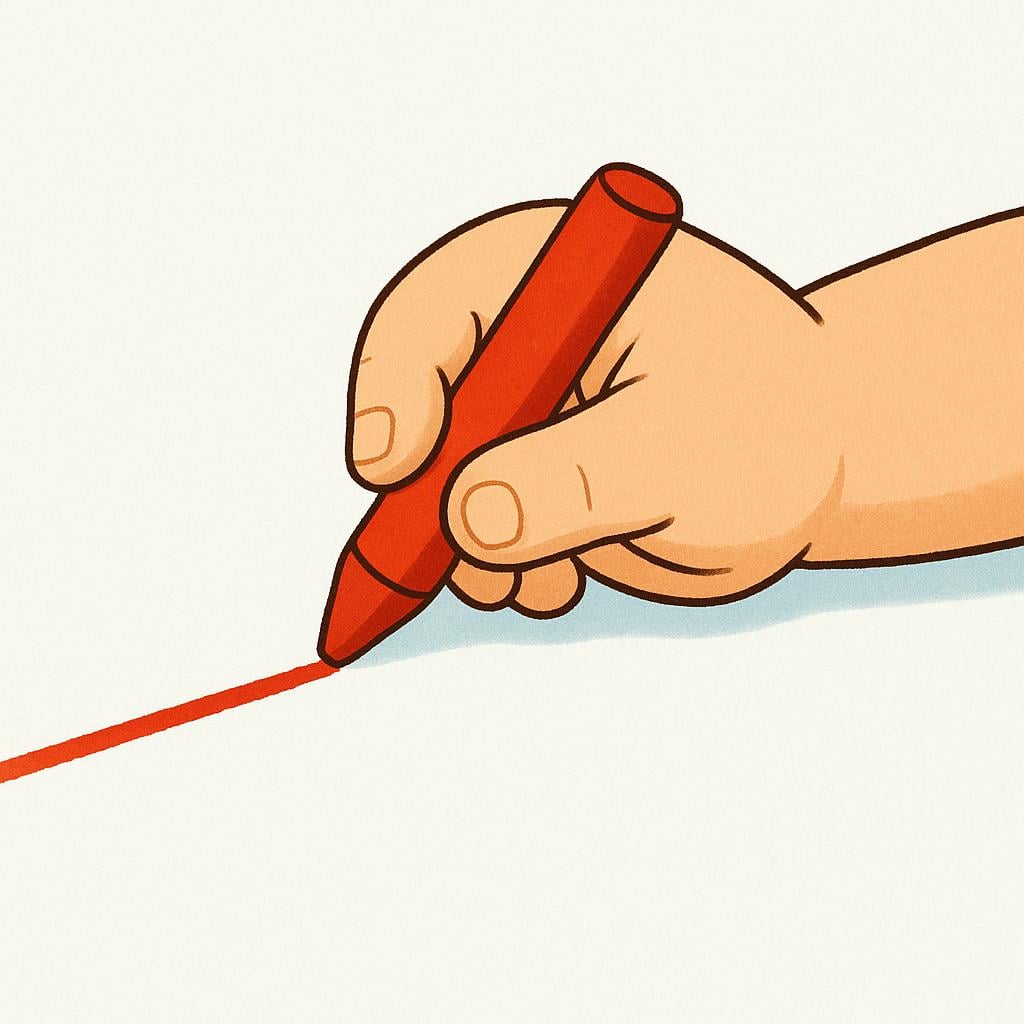línea
/LEE-neh-ah/
line

Una línea recta (A straight line). This illustrates the basic meaning of a drawn mark.
línea(Noun)
line
?a mark, stroke, or stripe
crease
?on fabric or paper
,wrinkle
?on skin, e.g., 'líneas de expresión'
📝 In Action
Dibuja una línea recta con la regla.
A1Draw a straight line with the ruler.
Sigue la línea amarilla en el suelo.
A2Follow the yellow line on the floor.
El pantalón tiene una línea bien marcada.
B1The pants have a well-defined crease.
💡 Grammar Points
Always Feminine: 'la línea'
Like most Spanish words ending in '-a', 'línea' is a feminine noun. This means you always use 'la' for 'the' or 'una' for 'a'. For example, 'la línea es larga' (the line is long).
⭐ Usage Tips
From Drawings to Wrinkles
This is the most basic meaning of 'línea'. Think of any long, thin mark: a line you draw, the stripes on a shirt, or even the wrinkles on a person's face. They can all be called 'líneas'.

Hacer línea (To form a line/queue). This illustrates the meaning of people waiting in sequence.
📝 In Action
Hay una línea muy larga para entrar al cine.
A2There's a very long line to get into the movie theater.
Por favor, haga línea para pagar.
B1Please form a line to pay.
❌ Common Pitfalls
Using 'hacer' for forming a line
Mistake: "Estoy haciendo una línea."
Correction: Hago línea. (I'm getting in line.) / Estoy en la línea. (I'm in the line.) You use 'hacer línea' as a set phrase, not something you are continuously 'doing'.
⭐ Usage Tips
Regional Differences: 'línea' vs. 'cola'
In many parts of Latin America, 'línea' or 'fila' is the standard word for a queue. In Spain, you'll almost always hear 'cola' (which literally means 'tail'). Everyone will understand you, but using the local term helps you sound more natural.

La línea de metro (The subway line/route).
📝 In Action
Tomo la línea 3 del metro todos los días.
A2I take line 3 of the subway every day.
¿Qué línea de autobús va al centro de la ciudad?
B1Which bus line goes to the city center?
⭐ Usage Tips
Just Like in English
This usage is very similar to English. You refer to specific routes by their number, color, or name, like 'la línea azul' (the blue line) or 'la línea 9'.

La línea telefónica (The telephone line).
📝 In Action
La línea está ocupada, por favor intente más tarde.
B1The line is busy, please try again later.
Se fue la luz, debe haber un problema con la línea eléctrica.
B2The power went out, there must be a problem with the power line.
Espera en línea, por favor. Te transferiré la llamada.
B1Hold the line, please. I will transfer your call.
⭐ Usage Tips
The Key to 'Online'
The phrase 'en línea' is the direct and universal translation for 'online'. You can use it for anything related to the internet: 'comprar en línea' (to buy online), 'jugar en línea' (to play online), or 'estoy en línea' (I'm online).

Una nueva línea de productos (A new line of products).
línea(Noun)
line
?a range of products
style
?e.g., of thought or policy
,policy
?a company's or person's stance
📝 In Action
La marca lanzó una nueva línea de productos para el cuidado de la piel.
B2The brand launched a new line of skin care products.
La línea editorial del periódico es bastante conservadora.
C1The newspaper's editorial line (policy) is quite conservative.
Todos los gerentes deben seguir la misma línea de actuación.
C1All managers must follow the same line of action.
⭐ Usage Tips
From Concrete to Abstract
This meaning extends the idea of a 'line' to more abstract concepts. Think of it as a consistent path or direction, whether it's for a series of products, a company's policy, or a way of thinking.
✏️ Quick Practice
💡 Quick Quiz: línea
Question 1 of 1
Which sentence uses 'línea' to talk about public transportation?
📚 More Resources
Frequently Asked Questions
What is the difference between 'línea', 'raya', and 'fila'?
Great question! 'Línea' is the most general word for any kind of line (drawn, abstract, etc.). 'Raya' often refers to a stripe or a scratch. 'Fila' is most commonly used for a row of things or people (like seats in a theater), but can also mean a queue, similar to 'línea'.
How do I say 'to cross the line' in Spanish?
The most common idiom is 'cruzar la línea' or 'pasarse de la raya'. Both mean to go too far or behave unacceptably. For example, 'Con ese comentario, te pasaste de la raya' (With that comment, you crossed the line).